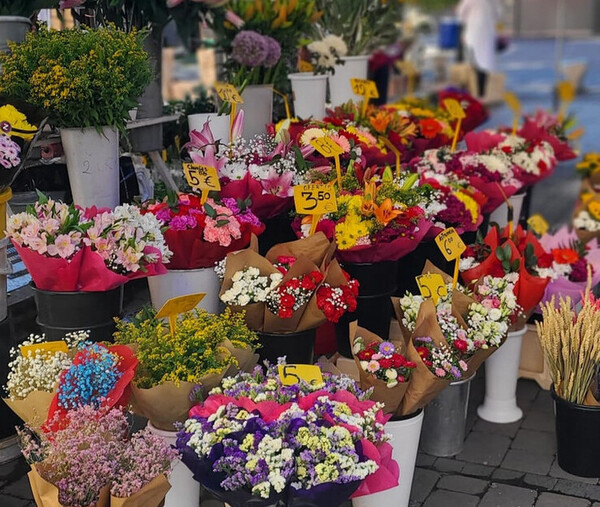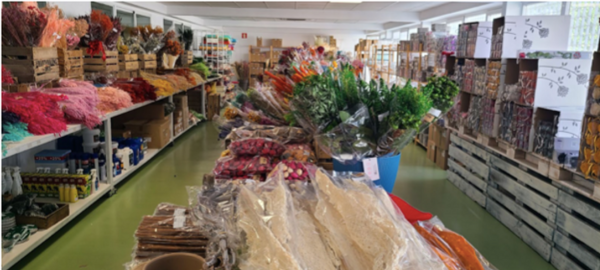Spain is a beautiful country, and Sahid Nahim, founder of New Bloom, had the pleasure of being on vacation recently for a couple of weeks. "I enjoy preparing for my travels and was interested in learning more about the industry and how it managed the COVID-19 pandemic. I have always believed we all can learn from each other no matter your country of origin because we may be doing the same things or going through the same things."

While Sahid visited Madrid, he had the pleasure of meeting Guillermo Gomez Weinzetl from Coflores. Guillermo and his brother welcomed him for a couple of hours to sit down for a talk and show him their facilities. "I wanted to learn how and where most of Spain and Madrid source its flowers, how business is changing for them, and how COVID-19 affected the industry."
Sahid was very impressed by the workshop classroom they had set up for their customers. They did not generate any profit. It was only a way of adding value and staying connected with their customers. During COVID, they had around 15 people. Now, they have more than 30. The room and facilities were top notches, which meant they invested into it and, as Sahid always says, "it is crucial to invest in your customers." It was a pleasure meeting the two brothers and hearing about the floral industry in Spain and Madrid. "I want to thank them for allowing me into their business and sharing with me their story."

"When I first sat down in Guillermo's office, I was impressed by his antique farm tool collection. The best I had ever seen. I love that stuff! I know it's not flowers, but it is farming, and it was super vintage. We spoke about the industry. He then showed me the workshop space from which he invites 30+ florists to learn from the best teachers in the world. I was very delighted to know that they only charge the cost to give back. We also entered the cooler full of locally grown products from Spain. Amazing! I also visited the preserved section, the largest I have ever seen, and the colors were just bursting like a skittle commercial."
Here is part of the conversation with Guillermo and his brother.
About the company
"I am Guillermo Gomez Weinzetl and I am the general manager of Comercializadora de Flores de Colombia (Coflores). This is a family company owned by four brothers. We have had this company since 1992. My father is from Colombia, and my mother is from Austria. We started importing flowers from Colombia, and then we started with Holland and then Ecuador, and now we import from all over the world. Colflores bought Florimex seven years ago when the headquarters in Holland went bankrupt, and we put the company together." Guillermo has been in business for about 30 years.
What are operating hours?
"We are open from 7 am until 7 pm. We sell to most flower shops and wholesalers, and the majority of them come starting at eight until 10 am, and others come later in the afternoon, but we mostly do delivery."
How does Guillermo normally sell?
They have a website where most of our customers buy. They used to make personal sales over the phone back in the days, but now we drive all people to the website to avoid wasting time over the phone. 70% of their sales are generated through the website. Their client base is all of Spain, not only Madrid. They deliver as far as Portugal and a little bit in France and have an office in Barcelona too.
Where do most of the flowers in Spain come from?
90% of flowers are imported because in Spain the production of flowers is really short. "We have excellent weather to grow flowers, but we are not used to doing it. Part of the locally grown product is hydrangeas but not too many. We also have carnations, chrysanthemums, glads, etc. most of these flowers are grown locally, Eucalyptus and some greens as well. Most of all, the other flowers come from Holland. We sell only the best quality. Carnations are shipped to Holland and England. Roses are the flowers people purchase the most. About 30% of all sales are roses from Colombia and Ecuador."
How was the situation during COVID-19?"
"During COVID, we had to close on March 14th of 2020, and all the purchases were already in process, so we shipped all the flowers on Sunday. Around 50,000 euros and then we closed and couldn't sell anything afterward. During the pandemic, we decided to give flowers to hospitals, nursing homes, police departments, pharmacies, fire departments, basically to all essential workers. After three weeks, people started to call again to ask for flowers. We started to bring a few flowers from Holland, but it was only my brother and I, and everyone else, our 30 employees, were working from home. My brother and I cleaned everything because we needed to throw all the products away. We opened, and people started to buy again, but the website never stopped. We started bringing some people to work, and finally, after one year, we came back to normal business."
How did the industry change in Spain during COVID-19?
"People were not used to buying flowers via the internet, so online flower sales grew. Many people who don't have flower shops have a website, and that's how they sell to their customers", Guillermo explains.
How is the market now?
Events and weddings restarted and increased sales. During the Summer, the sales normally drop. Last week they had 33% of sales. The weather affects the buying process since it's too hot to bring flowers home, but weddings are still active.
What does Guillermo think is the future of the flower industry?
"This is difficult to answer. I think people are changing their minds and they like to see new varieties and decorations. Florists like what they see on the internet, and they are looking for trends on social media and everywhere. For example, in Spain, there were a lot of flower decorations, but now there is more green incorporated."
For more information: 
New Bloom Solutions
www.newbloomsolutions.com
